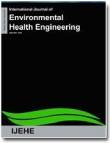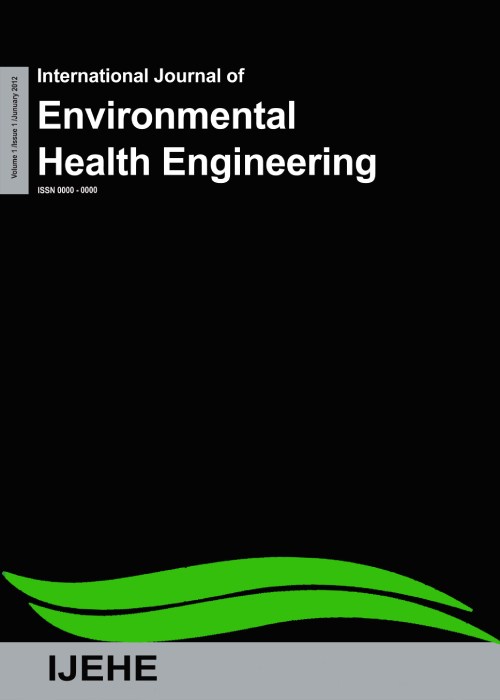فهرست مطالب

International Journal of Environmental Health Engineering
Volume:11 Issue: 2, Dec 2022
- تاریخ انتشار: 1401/09/22
- تعداد عناوین: 5
-
-
Page 1Aim
This article evaluates the health risk of occupational exposure to BTEX compounds, cancer risk, and noncancer risk analysis among gas station workers.
Materials and MethodsThis cross-sectional research evaluates pollutants rank of risk released at Ahvaz stations in Iran. We have collected 96 samples of workers exposed to BTEX and eight samples for control in the ambient air. The National Institute for Occupational Safety and Health (NIOSH) recommended BTEX method numbers 1500 and 1501 for sampling and analysis. To evaluate the risk assessment of pollutants, we utilized a semi-quantitative method offered by Singapore's Occupational Safety and Health Division.
ResultsThe average benzene concentration in the operators' breathing zone (1.202 0.83 ppm) was greater than the threshold limit values-time weighted average (TLVs-TWA) (P < 0.05). Other contaminants had concentrations that were lower than the ACGIH's TLV-TWA (P < 0.05). In gas stations, benzene has a very high danger ranking among chemical compounds. Toluene, ethyl benzene, and xylene in the employees' breathing zone posed a modest risk. The average cancer risk for benzene-exposed operators, head shift workers, and supervisors was calculated to be 4.46 × 10−3, 2.90 × 10−3, and 2.08 × 10−3, respectively. The risk of cancer is projected to be higher than the tolerable level of 10-6.
ConclusionIn unique, long-term exposure to benzene has been linked to an increased risk of cancer and toxic effects, and a health-risk assessment can provide useful information about current workplace contaminants.
Keywords: benzene, BTEX, cancer risk assessment, gas station, risk analysis, Volatile Organic Compounds -
Page 2Aim
A reliable model for wastewater treatment plants (WWTPs) is essential to provide a tool for predicting their performance and to form a basis for controlling the operation of the process also; this would minimize the operation costs. In recent years, computer-based methods have been applied to many areas of environmental issues. Artificial neural networks (ANNs) and genetic algorithm (GA) techniques could be applied for modeling WWTP processes, owing to their high accuracy, adequacy, and quite promising applications in engineering.
Materials and MethodsThis study applied multilayer feed forward back propagation neural network and GA to predict and optimize the performance of the second phase of the Isfahan North WWTP. Experimental results, which demonstrated the performance of the plant over 6 years were applied for modeling.
ResultsA three-layer neural network was developed as a predictive model and the network was trained with Levenberg–Marquardt algorithm. The chemical oxygen demand (COD), biochemical oxygen demand (BOD), total suspended solids (TSS), total kjeldahl nitrogen (TKN), and total phosphorus (TP) were introduced as the model input and output. Neural network performance was evaluated with correlation coefficient ® and least mean square error. Proposed model demonstrated the high consistency of the results of modeling and experiments. GA achieved the best value of input parameters as 324.36, 457.37, 359.11, 60.09, and 14.15 mg/l for BOD, COD, TSS, TKN, TP, respectively.
ConclusionANN and GA combination provides powerful analysis tool for modeling and optimization of nonlinear relationships between the parameters in WWTPs and could be used for proper design and operation of the WWTPs.
Keywords: Artificial Neural Network, Genetic algorithm, Modeling, wastewater -
Page 3Aim
Protection against nuclear radiation is one of the most important issues in nuclear technology and industries that use this technology. Among the types of radiation emitted from radioactive sources, neutron and gamma rays are among the most dangerous radiations due to lack of electrical charge and serious damage to living tissues. The principal challenge in radiation protection is the proper design of a shield against neutron and gamma radiations. Hence, this study has investigated the improvement of the protection against these radiations.
Materials and MethodsThis study is of applied-developmental and quantitative type. Calculations have been performed using the MCNPX code in this study, which is one of the strongest nuclear calculation codes. The data were analyzed using quantitative statistics and ORIGIN software (OriginLab company, 1992, Northampton, Massachusetts, USA).
ResultsBased on the results, utilizing the spherical geometry had a better performance to increase the neutron fluxes in comparison with the cylindrical and cubic geometries. Moreover, polyethylene with high density was selected as the best moderator. Ultimately, it was dealt with the comparison and selection of the best protection to minimize the produced gamma rays due to the absorption of neutrons in different materials used by the source and neutrons that run away from the outer surface of the source configuration.
ConclusionUsing the composite sphere of paraffin and polyethylene with high density up to a radius of 12 cm and tungsten with a thickness of 1 cm was suggested as the final configuration for the aim of this study. In comparison to the no-protection mode, this protection is effective to 74% in reducing the neuron dosage and 55% in reducing the primary gamma-ray, while the mentioned protection is about 72%–73% effective in reducing the general dose.
Keywords: Am‑be source, mixed radiation field, Monte‑Carlo computations, Protection -
Page 4Aim
Hydatid cyst is the Echinococcus granulosus larvae stage and is responsible for echinococcosis. Anticancer effects of hydatid cyst have been shown in human population, experimental animals, and in vitro works. However, the mechanisms of this anticancer activity are not clarified. Hence, in this work, the effect of antisera raised against hydatid cyst antigens on the growth of breast cancer cells has been investigated.
Materials and MethodsIn this experimental study, the various hydatid cyst antigens were prepared. To raise antisera, each of the hydatid cyst antigens (hydatid cyst fluid, germinal and laminated, protoscolex, and excretory-secretory [ES]) and toxoplasma trophozoite were injections to rabbits. The production of specific antibodies in rabbits determinate by enzyme-linked immunoassay, and then, the rabbit's blood was taken, and their sera isolated under the hood in sterile conditions. Before use, all antisera were inactivated at 56°C for half an hour and also placed under ultraviolet light for 20 min to disinfect. Breast cancer cells in the culture medium were purchased from the Pasteur Institute of Iran and growth in CO2 incubator in the Roswell Park Memorial Institute (RPMI) medium. After appropriate, the cells were counted and divided equally in eight-cell culture flasks and treated with different antisera of hydatid cyst. After 32-h incubation, the number of live cells was counted by trypan blue methods and compared with control groups.
ResultsBased on the results of this research, the difference between the number of live cells after treatment with antisera against hydatid cyst fluid, toxoplasma trophozoite, and ES antigen was significantly different from number of cells in flask treated with normal rabbit serum.
ConclusionIn conclusion, due to the presence of common antigens between parasites and cancer, probably antibodies produced against hydatid cyst antigens may affect the growth of cells in the culture media.
Keywords: Breast cancer cell (4T), Hydatid cyst, polyspecific antiserum


